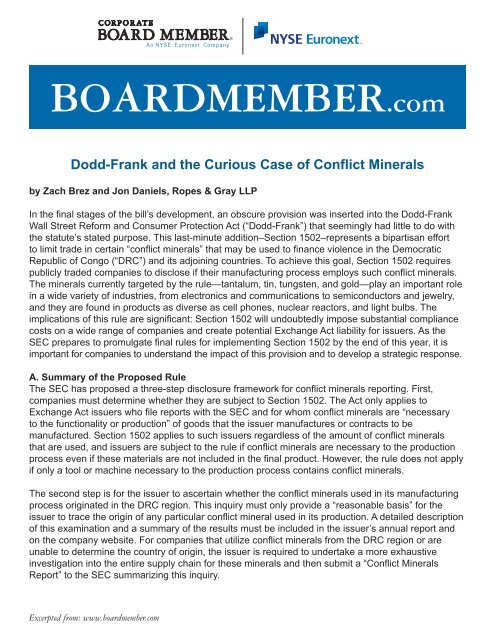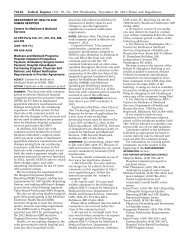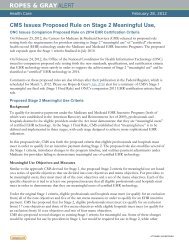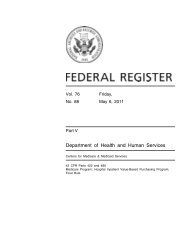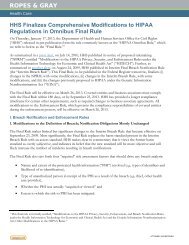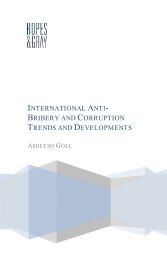Dodd-Frank and the Curious Case of Conflict Minerals - Ropes & Gray
Dodd-Frank and the Curious Case of Conflict Minerals - Ropes & Gray
Dodd-Frank and the Curious Case of Conflict Minerals - Ropes & Gray
Create successful ePaper yourself
Turn your PDF publications into a flip-book with our unique Google optimized e-Paper software.
<strong>Dodd</strong>-<strong>Frank</strong> <strong>and</strong> <strong>the</strong> <strong>Curious</strong> <strong>Case</strong> <strong>of</strong> <strong>Conflict</strong> <strong>Minerals</strong>by Zach Brez <strong>and</strong> Jon Daniels, <strong>Ropes</strong> & <strong>Gray</strong> LLPIn <strong>the</strong> final stages <strong>of</strong> <strong>the</strong> bill’s development, an obscure provision was inserted into <strong>the</strong> <strong>Dodd</strong>-<strong>Frank</strong>Wall Street Reform <strong>and</strong> Consumer Protection Act (“<strong>Dodd</strong>-<strong>Frank</strong>”) that seemingly had little to do with<strong>the</strong> statute’s stated purpose. This last-minute addition–Section 1502–represents a bipartisan effortto limit trade in certain “conflict minerals” that may be used to finance violence in <strong>the</strong> DemocraticRepublic <strong>of</strong> Congo (“DRC”) <strong>and</strong> its adjoining countries. To achieve this goal, Section 1502 requirespublicly traded companies to disclose if <strong>the</strong>ir manufacturing process employs such conflict minerals.The minerals currently targeted by <strong>the</strong> rule—tantalum, tin, tungsten, <strong>and</strong> gold—play an important rolein a wide variety <strong>of</strong> industries, from electronics <strong>and</strong> communications to semiconductors <strong>and</strong> jewelry,<strong>and</strong> <strong>the</strong>y are found in products as diverse as cell phones, nuclear reactors, <strong>and</strong> light bulbs. Theimplications <strong>of</strong> this rule are significant: Section 1502 will undoubtedly impose substantial compliancecosts on a wide range <strong>of</strong> companies <strong>and</strong> create potential Exchange Act liability for issuers. As <strong>the</strong>SEC prepares to promulgate final rules for implementing Section 1502 by <strong>the</strong> end <strong>of</strong> this year, it isimportant for companies to underst<strong>and</strong> <strong>the</strong> impact <strong>of</strong> this provision <strong>and</strong> to develop a strategic response.A. Summary <strong>of</strong> <strong>the</strong> Proposed RuleThe SEC has proposed a three-step disclosure framework for conflict minerals reporting. First,companies must determine whe<strong>the</strong>r <strong>the</strong>y are subject to Section 1502. The Act only applies toExchange Act issuers who file reports with <strong>the</strong> SEC <strong>and</strong> for whom conflict minerals are “necessaryto <strong>the</strong> functionality or production” <strong>of</strong> goods that <strong>the</strong> issuer manufactures or contracts to bemanufactured. Section 1502 applies to such issuers regardless <strong>of</strong> <strong>the</strong> amount <strong>of</strong> conflict mineralsthat are used, <strong>and</strong> issuers are subject to <strong>the</strong> rule if conflict minerals are necessary to <strong>the</strong> productionprocess even if <strong>the</strong>se materials are not included in <strong>the</strong> final product. However, <strong>the</strong> rule does not applyif only a tool or machine necessary to <strong>the</strong> production process contains conflict minerals.The second step is for <strong>the</strong> issuer to ascertain whe<strong>the</strong>r <strong>the</strong> conflict minerals used in its manufacturingprocess originated in <strong>the</strong> DRC region. This inquiry must only provide a “reasonable basis” for <strong>the</strong>issuer to trace <strong>the</strong> origin <strong>of</strong> any particular conflict mineral used in its production. A detailed description<strong>of</strong> this examination <strong>and</strong> a summary <strong>of</strong> <strong>the</strong> results must be included in <strong>the</strong> issuer’s annual report <strong>and</strong>on <strong>the</strong> company website. For companies that utilize conflict minerals from <strong>the</strong> DRC region or areunable to determine <strong>the</strong> country <strong>of</strong> origin, <strong>the</strong> issuer is required to undertake a more exhaustiveinvestigation into <strong>the</strong> entire supply chain for <strong>the</strong>se minerals <strong>and</strong> <strong>the</strong>n submit a “<strong>Conflict</strong> <strong>Minerals</strong>Report” to <strong>the</strong> SEC summarizing this inquiry.Excerpted from: www.boardmember.com
The third step provides additional guidance on <strong>the</strong> <strong>Conflict</strong> <strong>Minerals</strong> Report. This Report mustdescribe <strong>the</strong> due diligence process undertaken to trace <strong>the</strong> source <strong>and</strong> chain <strong>of</strong> custody <strong>of</strong> <strong>the</strong>company’s conflict minerals throughout <strong>the</strong> supply chain. Although <strong>the</strong> proposed rule does notprescribe specific st<strong>and</strong>ards for this inquiry, <strong>the</strong> SEC references guidelines from <strong>the</strong> Organisation forEconomic Cooperation <strong>and</strong> Development’s Draft Due Diligence Guidance for Responsible SupplyChains <strong>of</strong> <strong>Minerals</strong> from <strong>Conflict</strong>-Affected <strong>and</strong> High-Risk Areas report as a “good starting point.” Theissuer must have this Report certified by an independent private sector auditor. The Report mustidentify which <strong>of</strong> <strong>the</strong> issuer’s products may have used conflict minerals <strong>and</strong> it must describe <strong>the</strong>specific facilities used to process those conflict minerals. Issuers are required to include this Reportas an exhibit in <strong>the</strong>ir annual report <strong>and</strong> to make <strong>the</strong> Report available on <strong>the</strong> company website. Under<strong>the</strong> proposed rule, <strong>the</strong> Report will not be “filed” for purposes <strong>of</strong> Exchange Act liability but instead willonly be “furnished” to <strong>the</strong> Commission; however, <strong>the</strong> provision’s co-sponsors have noted that <strong>the</strong>y are“deeply troubled” by this approach since <strong>the</strong>y had intended that issuers be subject to <strong>the</strong> broaderliabilities <strong>of</strong> <strong>the</strong> Exchange Act.B. Analysis1. Impact on CompaniesIn its commentary on <strong>the</strong> proposed rule, <strong>the</strong> SEC estimates that Section 1502 will lead to an annualcompliance cost <strong>of</strong> more than $70 million dollars <strong>and</strong> that nearly 1,200 issuers will ultimately have t<strong>of</strong>urnish a <strong>Conflict</strong> <strong>Minerals</strong> Report. Many companies have noted in <strong>the</strong>ir Comment Letters that <strong>the</strong>sefigures vastly understate <strong>the</strong> true costs <strong>of</strong> <strong>the</strong> provision. For example, <strong>the</strong> National Association <strong>of</strong>Manufacturers (“NAM”) suggests that public companies <strong>and</strong> <strong>the</strong>ir suppliers will face costs between $9<strong>and</strong> $16 billion because issuers will have to undertake onerous actions such as developing new ITsystems, revising legal obligations, <strong>and</strong> developing due diligence programs for lengthy supply chains.NAM compared <strong>the</strong> conflict minerals disclosure to an analogous 2006 EU regulation that requiredcompanies to trace <strong>the</strong> use <strong>of</strong> certain hazardous materials in <strong>the</strong>ir production processes; thisprovision cost more than $32 billion for initial compliance <strong>and</strong> $3 billion annually <strong>the</strong>reafter. Moreover,<strong>the</strong> costs <strong>of</strong> this provision will extend beyond issuers subject to Section 1502, since companiesthroughout <strong>the</strong> supply chain will be forced to perform <strong>the</strong>ir own diligence <strong>and</strong> <strong>the</strong>n report back tothose issuers.2. Timeline for Adoption <strong>and</strong> Implementation<strong>Dodd</strong>-<strong>Frank</strong> required <strong>the</strong> SEC to issue final rules implementing <strong>the</strong> <strong>Conflict</strong> <strong>Minerals</strong> provision byApril 15, 2011. This deadline has been delayed by <strong>the</strong> SEC <strong>and</strong> <strong>the</strong> Commission now intends to issuea final rule by <strong>the</strong> end <strong>of</strong> 2011. The SEC’s timeline will likely be affected by a recent court decisionstriking down an unrelated SEC rule. In Business Roundtable v. S.E.C., 2011 WL 2936808 (D.C. Cir.2011), <strong>the</strong> D.C. Circuit found that <strong>the</strong> SEC had acted “arbitrarily <strong>and</strong> capriciously” in implementing a<strong>Dodd</strong>-<strong>Frank</strong> rule regarding proxy access <strong>and</strong> emphasized that <strong>the</strong> SEC had failed to realisticallyassess <strong>the</strong> rule’s effect upon efficiency, competition <strong>and</strong> capital formation. The enormous potentialcosts imposed by Section 1502 <strong>and</strong> <strong>the</strong> uncertain benefits <strong>of</strong> <strong>the</strong> rule—as suggested by severalrecent articles—may make it difficult for <strong>the</strong> SEC to satisfy <strong>the</strong> analysis required by <strong>the</strong> D.C. Circuit.Although Business Roundtable may not prove fatal to <strong>the</strong> conflict minerals provision, it will likely delayfinal implementation <strong>of</strong> Section 1502 while <strong>the</strong> SEC makes sure that its proposed rule can withst<strong>and</strong>judicial scrutiny.Excerpted from: www.boardmember.com
Despite <strong>the</strong> impact <strong>of</strong> Business Roundtable, it is unlikely that <strong>the</strong> SEC will extend its deadline for <strong>the</strong>final rule beyond 2011. The initial <strong>Conflict</strong> <strong>Minerals</strong> Report must be filed as part <strong>of</strong> <strong>the</strong> issuer’s annualreport for <strong>the</strong> first full fiscal year following promulgation <strong>of</strong> <strong>the</strong> SEC’s final rules. Any delay past <strong>the</strong>end <strong>of</strong> this year would <strong>the</strong>refore imply that issuers with a December 31 fiscal year-end would not berequired to furnish <strong>the</strong>ir initial report until <strong>the</strong> filing <strong>of</strong> <strong>the</strong>ir 2013 annual report.C. Action StepsAs an initial matter, companies that report to <strong>the</strong> SEC should determine whe<strong>the</strong>r <strong>the</strong>ir manufacturingprocess employs <strong>the</strong> use <strong>of</strong> any conflict minerals <strong>and</strong> whe<strong>the</strong>r such minerals originated in <strong>the</strong> DRCregion. Companies that utilize conflict minerals from <strong>the</strong> DRC region should begin developing a duediligence approach for <strong>the</strong>ir supply chain, including discussions with an independent auditor to certify<strong>the</strong> process <strong>and</strong> interviews with suppliers to identify particular risks. Issuers should also considerdiscussing Section 1502 with industry representatives in order to develop an industry-wide approachfor tracing <strong>the</strong>se minerals.Actions already undertaken by several prominent companies can also provide guidance for firms.For example, Motorola has revised its contracts to require suppliers to trace <strong>and</strong> certify <strong>the</strong> origin <strong>of</strong>minerals used in its manufacturing. O<strong>the</strong>r companies such as Apple <strong>and</strong> Intel have agreed to <strong>the</strong>“<strong>Conflict</strong>-Free Smelter program” which requires mineral processors to certify that <strong>the</strong>ir purchases donot contribute to conflict in <strong>the</strong> eastern Congo.D. ConclusionAs <strong>the</strong> numerous Comment Letters on <strong>the</strong> proposed SEC rule make clear, <strong>the</strong> implementation <strong>of</strong>Section 1502 will involve many complex issues for a diverse mix <strong>of</strong> companies <strong>and</strong> industries. Eventhough <strong>the</strong> SEC has not finalized its conflict minerals rule <strong>and</strong> a number <strong>of</strong> key provisions in <strong>the</strong>Proposed Rule remain undefined, issuers would be prudent to examine <strong>the</strong> impact <strong>of</strong> this rule on<strong>the</strong>ir business <strong>and</strong> to prepare for its implementation.Zach Brez is a securities litigation partner in <strong>Ropes</strong> & <strong>Gray</strong>’s New York <strong>of</strong>fice. He representsinternational <strong>and</strong> domestic public <strong>and</strong> private corporations, financial services firms, <strong>and</strong> private equity<strong>and</strong> hedge funds in a variety <strong>of</strong> settings, from <strong>the</strong> boardroom to <strong>the</strong> courtroom. Before going intoprivate practice in 2002, Zach was a staff attorney in <strong>the</strong> New York Office <strong>of</strong> <strong>the</strong> SEC’s Division <strong>of</strong>Enforcement. He can be reached at zachary.brez@ropesgray.com. Jon Daniels is an associate in<strong>Ropes</strong> & <strong>Gray</strong>’s New York <strong>of</strong>fice. He can be reached at jon.daniels@ropesgray.com.Note to readers: This Article is intended to provide a high-level overview <strong>of</strong> Section 1502. As such,several important details <strong>of</strong> <strong>the</strong> rule are beyond <strong>the</strong> scope <strong>of</strong> this paper. As one example <strong>of</strong> asignificant issue that is not discussed, <strong>the</strong> proposed rule allows for different treatment <strong>of</strong> conflictminerals from recycled <strong>and</strong> scrap sources than from mined sources. Companies are encouragedto review <strong>the</strong> SEC commentary on <strong>the</strong> proposed rule for a more in-depth analysis <strong>of</strong> <strong>the</strong> regulation.Excerpted from: www.boardmember.com


